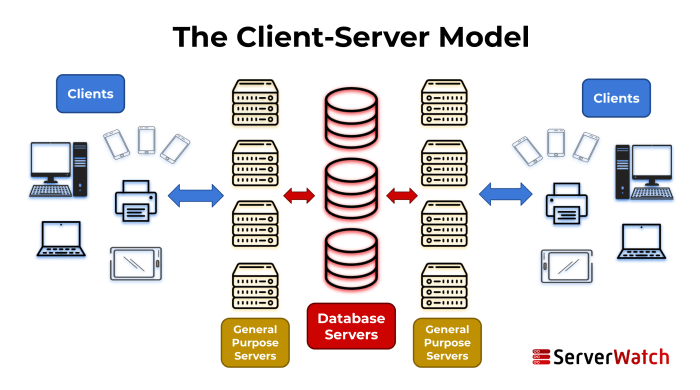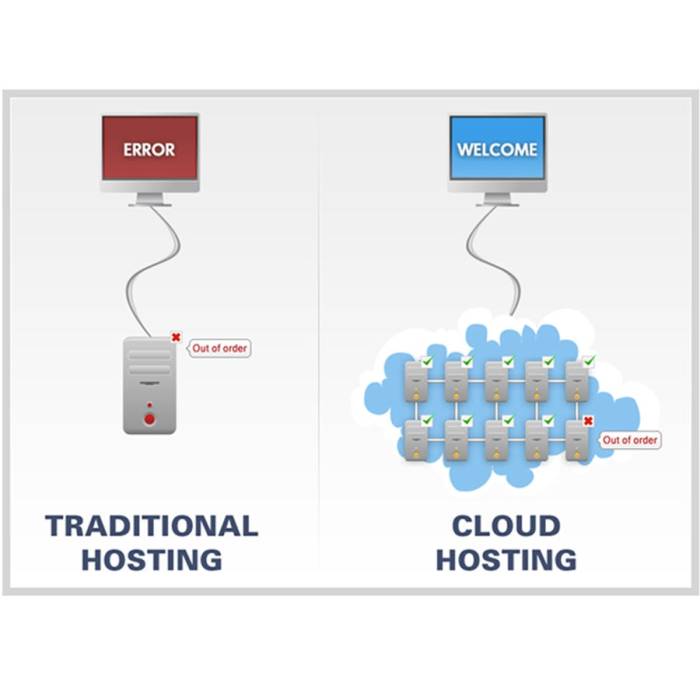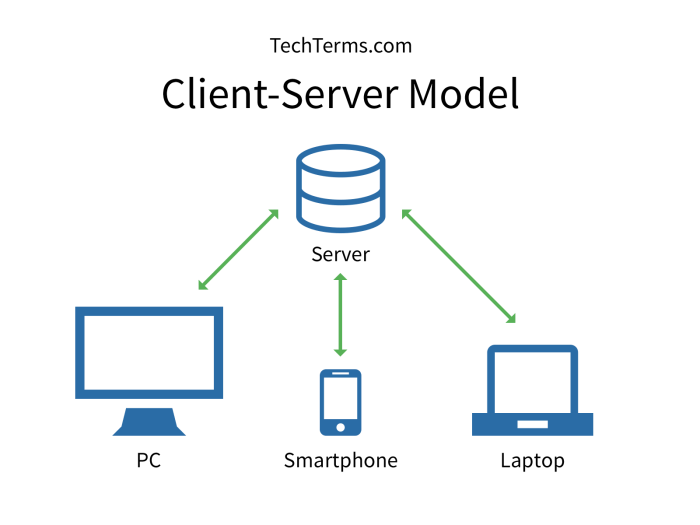Cloud computing vs client server model – Cloud computing vs client-server model: It’s a debate as old as the internet itself, really. Choosing between these two fundamental architectures is a crucial decision for any business, large or small. This comparison dives into the core differences, weighing scalability, security, cost, and ease of use to help you determine which model best fits your needs. We’ll explore the strengths and weaknesses of each, providing real-world examples to illustrate the points.
From the traditional client-server setup, where everything runs on your own hardware, to the flexible and scalable cloud, the options are vast. Understanding the implications of each choice is key to building a robust and efficient system. We’ll break down the intricacies of IaaS, PaaS, and SaaS, comparing them to the more familiar client-server model to give you a clear picture of how these technologies stack up.
Defining Cloud Computing and Client-Server Models

The client-server model and cloud computing represent fundamentally different approaches to computing architecture, each with its own strengths and weaknesses. Understanding their core components and underlying technologies is crucial for choosing the right solution for specific needs. This section will delve into the specifics of each model, highlighting their key features and differences.
The client-server model is a distributed application architecture where clients request services from a central server. Clients are typically desktop computers, laptops, or mobile devices, while servers are powerful computers designed to handle multiple client requests simultaneously. This model has been the backbone of many applications for decades.
Client-Server Model Architecture
The fundamental architecture of a client-server model involves a clear separation of roles between clients and servers. Clients initiate requests, while servers respond to these requests by providing data or services. This interaction usually occurs over a network, often the internet. A typical setup might include a web server responding to requests from web browsers (clients), a database server managing data, and an application server processing client requests and interacting with the database.
The communication between clients and servers typically follows a request-response pattern. The client sends a request, and the server processes the request and sends back a response.
Cloud Computing Core Components
Cloud computing offers a different paradigm, shifting the focus from owning and managing infrastructure to consuming computing resources as a service. Three main service models define the cloud landscape: Infrastructure as a Service (IaaS), Platform as a Service (PaaS), and Software as a Service (SaaS).
IaaS provides the foundational building blocks of computing, including virtual machines, storage, and networking. Think of it as renting a virtual data center. Examples include Amazon EC2, Microsoft Azure Virtual Machines, and Google Compute Engine. PaaS provides a platform for developing, running, and managing applications without the need to manage the underlying infrastructure. It often includes tools and services for database management, application deployment, and scaling.
Examples include Heroku, Google App Engine, and AWS Elastic Beanstalk. SaaS provides ready-to-use software applications over the internet. Users access these applications through a web browser or mobile app without managing any infrastructure or platform. Examples include Salesforce, Gmail, and Microsoft Office 365.
Underlying Technologies: A Comparison
Client-server models traditionally rely on proprietary protocols and technologies specific to the application. For example, a custom database might be used in conjunction with a proprietary application server. Cloud computing, on the other hand, leverages standardized technologies such as virtualization, containerization (Docker, Kubernetes), and APIs (Application Programming Interfaces) to provide flexibility and scalability. This standardization allows for greater interoperability and ease of integration between different cloud services and applications.
While both models utilize networking protocols like TCP/IP, the cloud’s reliance on virtualization and APIs creates a more abstracted and flexible architecture.
Real-World Applications
The client-server model powers countless applications, including traditional email systems (like an on-premise Exchange server), local area network file sharing, and many enterprise resource planning (ERP) systems. In contrast, cloud computing is behind many modern applications, including online gaming services (using IaaS for server infrastructure), collaborative software development platforms (using PaaS for development and deployment), and subscription-based software like video streaming services (using SaaS to deliver the application directly to users).
Many modern applications blend aspects of both models, leveraging cloud services for scalability and flexibility while maintaining a client-server interaction pattern.
Data Management and Security: Cloud Computing Vs Client Server Model

Data management and security represent a critical difference between client-server and cloud computing models. While both architectures face security risks, the nature and scale of these challenges, along with the approaches to mitigating them, differ significantly. Understanding these differences is vital for choosing the right model for your specific needs.
Data Security Challenges in Client-Server Environments
Client-server architectures present several data security challenges. A primary concern is the security of the data residing on individual client machines. These machines are often less centrally managed than those in a cloud environment, making them vulnerable to malware, unauthorized access, and data breaches. Furthermore, securing the network connection between clients and the server is crucial, as any weakness can expose sensitive data during transmission.
Finally, maintaining consistent security policies and updates across a potentially large and diverse range of client machines can be a significant administrative burden. Data loss due to hardware failure on a client machine or the server itself is another major risk.
Data Security Best Practices in Cloud Computing Environments
Cloud providers invest heavily in security infrastructure and offer a range of features to protect data. Best practices include leveraging encryption both in transit (using protocols like HTTPS) and at rest (encrypting data stored on the cloud provider’s servers). Employing strong access control mechanisms, such as multi-factor authentication and role-based access control (RBAC), limits access to authorized users only.
Regular security audits and penetration testing help identify vulnerabilities before malicious actors can exploit them. Choosing a reputable cloud provider with robust security certifications and compliance with relevant regulations (like HIPAA or GDPR) is also crucial. Finally, implementing data loss prevention (DLP) measures helps prevent sensitive data from leaving the cloud environment unauthorized.
Data Backup and Recovery Methods
Client-server architectures typically rely on local backups of client data and server-side backups of critical databases and applications. Recovery involves restoring data from these backups, which can be a time-consuming process, especially in case of widespread data loss. Cloud computing offers various backup and recovery solutions, including automated backups, versioning (multiple versions of files), and disaster recovery services.
Recovery from cloud-based backups is often faster and more efficient, leveraging the cloud provider’s infrastructure for quick restoration. The cloud’s scalability also allows for easier recovery from large-scale data loss events.
Comparison of Data Security Features
| Feature | Client-Server | Cloud Computing |
|---|---|---|
| Data Encryption | Often implemented, but can be inconsistent across clients | Generally robust encryption both in transit and at rest |
| Access Control | Can be challenging to manage across many clients | Sophisticated access control mechanisms (RBAC, MFA) readily available |
| Backup and Recovery | Relies on local and server-side backups; can be complex and time-consuming | Automated backups, versioning, and disaster recovery services readily available |
| Security Monitoring | Requires significant manual effort | Comprehensive security monitoring and logging capabilities often included |
Accessibility and Collaboration

Cloud computing and client-server models differ significantly in how they handle accessibility and collaboration, impacting user experience and the feasibility of remote work. The shift towards remote work has dramatically highlighted these differences, making the choice between the two models a crucial strategic decision for businesses.Cloud computing offers unparalleled accessibility. Users can access data and applications from virtually anywhere with an internet connection, using a variety of devices.
This contrasts sharply with client-server architectures, which typically require users to be connected to a specific internal network or VPN. This limitation can severely restrict access, especially for remote workers or those needing access outside of regular office hours.
Accessibility Features Comparison
Cloud computing excels in accessibility. Its inherent design allows access from any device with internet connectivity, regardless of location. Think of accessing your Google Drive files from your phone, laptop, or even a friend’s computer – all you need is your login credentials. Client-server models, however, usually confine access to the local network. Accessing data remotely often necessitates complex VPN setups and configurations, increasing both the technical hurdle and the potential for security vulnerabilities.
This stark difference makes cloud computing far more accessible for geographically dispersed teams and remote workers.
Cloud Computing’s Facilitation of Collaboration
Cloud-based platforms are built for collaboration. Real-time co-editing of documents, shared workspaces, and integrated communication tools are standard features. Imagine a team working on a marketing campaign; with cloud computing, they can simultaneously edit a presentation, share design files, and discuss strategies all within the same platform, eliminating the need for cumbersome email chains or version control nightmares.
This streamlined workflow significantly boosts productivity and simplifies collaboration, which is especially crucial for geographically distributed teams. Client-server models, while capable of supporting collaboration, often require more complex setups and lack the integrated features found in cloud solutions.
User Experience and Interface Differences
Cloud-based applications generally offer a more intuitive and user-friendly experience. The interfaces are typically designed for simplicity and ease of use, requiring minimal technical expertise. Many cloud services are browser-based, eliminating the need for complex software installations and updates on individual devices. Client-server applications, on the other hand, often involve more complex installations, updates, and configurations, potentially requiring specialized technical knowledge.
This difference in user experience can be a significant factor when considering the overall productivity and efficiency of a team.
Impact of Remote Work on Model Selection, Cloud computing vs client server model
The rise of remote work has made cloud computing the preferred choice for many organizations. The inherent accessibility and collaborative features of cloud solutions are perfectly suited to the needs of a dispersed workforce. Companies that rely heavily on remote workers find it significantly more challenging and costly to manage and maintain client-server infrastructure, particularly regarding security, updates, and support.
The ability to seamlessly access and collaborate on data and applications from anywhere is a key advantage that directly impacts productivity and business continuity in a remote work environment. The shift towards remote work has undeniably cemented the dominance of cloud computing over client-server models in many sectors.
Ultimately, the “best” model – cloud computing or client-server – depends entirely on your specific needs and priorities. While cloud computing offers incredible scalability, flexibility, and often lower upfront costs, the client-server model provides more control and potentially greater security for certain applications. By carefully weighing the factors discussed – scalability, security, cost, and management – you can make an informed decision that aligns with your business goals and resources.
Remember to consider future growth and potential changes in your technological needs when making your choice.
Questions Often Asked
What are the security risks associated with each model?
Client-server models face risks like on-site data breaches and hardware failures. Cloud computing introduces risks related to data privacy and vendor lock-in, though reputable providers have robust security measures.
How much does each model typically cost?
Client-server models have high upfront costs for hardware and software but lower ongoing costs. Cloud computing usually has lower upfront costs but potentially higher ongoing expenses depending on usage.
Which model is better for small businesses?
For small businesses, cloud computing often offers a better balance of cost and scalability. However, client-server might be suitable if tight security control over sensitive data is paramount.
What about disaster recovery?
Cloud providers typically offer robust disaster recovery solutions built into their services. Client-server models require dedicated disaster recovery planning and infrastructure.